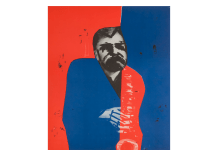Playing at the Playhouse Theater in Santa Monica, “Smoke and Mirrors” is actor Albie Selznick’s dramatic re-entry into the world of magic. Chronicling his life through magic, Selznick shares his opinions on life, death, New Zealand and 1970s hairstyles in his new show. Filled with nutty humor, “Smoke and Mirrors” flawlessly combines illusions and sleight of hand into an overarching storyline, but disjointedly transitions from one moment to the next.
Showing how he has grown from an amateur to a professional, Selznick displays his vast repertoire of magic tricks. His sleight of hand tricks range from the elemental to the complex, and his expert misdirection leads on even the keenest observer. Although his earlier tricks are banal, he cleverly disguises their shortcomings with uproarious jokes. In addition to the simple “Miser’s Dream” tricks, he performs wondrous illusions, including the swallowing of razor blades. As a whole, Selznick undoubtedly and fearlessly demonstrates his mastery of magic.
To guide the performance, the magician partially revolves his show around psychic communication. During the occasional lulls, two screens repeatedly show master magician/escape artist Harry Houdini’s reels from the early 20th century. They reveal that Houdini’s wife attempted to contact her husband’s soul for 10 years after his death. Inspired by the woman’s attempt to confer with the deceased, Selznick uses Houdini’s story to tell his own. After the magician dabbles with the paranormal for one of his tricks, Houdini is never heard from again. As a result, it reveals an unfinished storyline in the show. Instead of Houdini disappearing forever, Selznick should bring him back for the finale. Otherwise, Houdini will always be a loose end.
Very skilled with delivering humor, the magician makes an effort to express his softer, gentler side. Toward the end of “Smoke and Mirrors,” Selznick reminisces about his previous performances in New Zealand. After one of his gigs, he met a 6-year-old boy with severe physical handicaps. Although theoretically moving, the storyteller does not personally connect with the audience. In fact, the transitions from a hilarious joke to a depressing story rouse an uncomfortable feeling. While he recounts a melancholy tale, the audience is still smiling from the last joke. Because the audience is unsure whether to laugh or cry, Selznick still needs to perfect the art of dramaturgy.
Throughout the play, one constant facet is the “fear box,” in which Selznick physically places all of his insecurities and doubts. The fear box ultimately culminates in the magician’s finale. With the help of his magical bunny, Trixie, he wows the audience with a brilliant illusion. A new take on the age-old disappearing act, the final number leaves the audience breathless and wondering.
Without a doubt, Selznick brilliantly performs his magic and his finale exceeds all expectations. Unfortunately, his attempt to elicit an emotional response lacks in meaningful progression. As such, the heartbreaking moments are constrained with quizzical brows and confused looks. Although “Smoke and Mirrors” could improve its writing, Selznick proudly lives up to the show’s message: “Face your fears, for they are only smoke and mirrors.”
Natalia Evdokimova has been involved with theater throughout her life and has reviewed theatrical productions for local and citywide publications since 2005.













